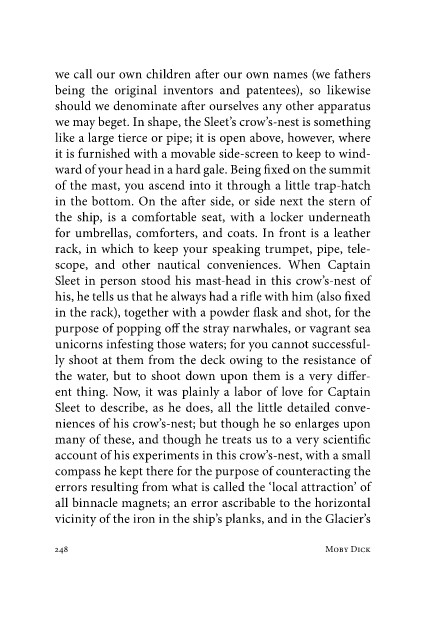Page 249 - moby-dick
P. 249
we call our own children after our own names (we fathers
being the original inventors and patentees), so likewise
should we denominate after ourselves any other apparatus
we may beget. In shape, the Sleet’s crow’s-nest is something
like a large tierce or pipe; it is open above, however, where
it is furnished with a movable side-screen to keep to wind-
ward of your head in a hard gale. Being fixed on the summit
of the mast, you ascend into it through a little trap-hatch
in the bottom. On the after side, or side next the stern of
the ship, is a comfortable seat, with a locker underneath
for umbrellas, comforters, and coats. In front is a leather
rack, in which to keep your speaking trumpet, pipe, tele-
scope, and other nautical conveniences. When Captain
Sleet in person stood his mast-head in this crow’s-nest of
his, he tells us that he always had a rifle with him (also fixed
in the rack), together with a powder flask and shot, for the
purpose of popping off the stray narwhales, or vagrant sea
unicorns infesting those waters; for you cannot successful-
ly shoot at them from the deck owing to the resistance of
the water, but to shoot down upon them is a very differ-
ent thing. Now, it was plainly a labor of love for Captain
Sleet to describe, as he does, all the little detailed conve-
niences of his crow’s-nest; but though he so enlarges upon
many of these, and though he treats us to a very scientific
account of his experiments in this crow’s-nest, with a small
compass he kept there for the purpose of counteracting the
errors resulting from what is called the ‘local attraction’ of
all binnacle magnets; an error ascribable to the horizontal
vicinity of the iron in the ship’s planks, and in the Glacier’s
Moby Dick

